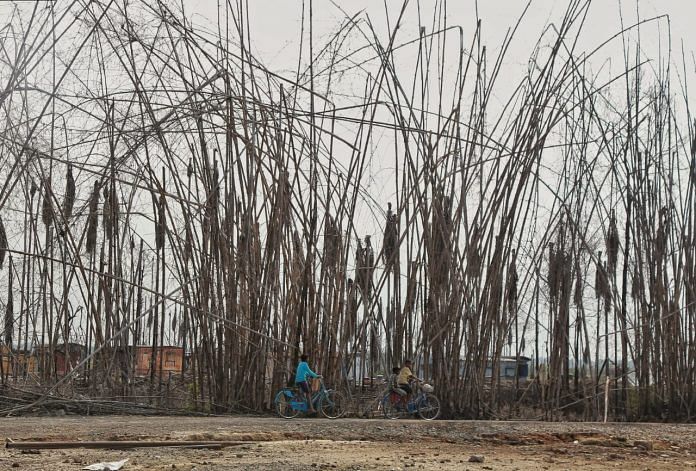Bamboo, officially a grass, is the fastest-growing plant on earth. Many variants are ready to harvest in just three years, when they’re cut down to their base from where they start to sprout again. As bamboo grows it absorbs carbon from the atmosphere, with one hectare of bamboo sequestering about 17 tonnes of carbon a year. And, crucially, unlike standard building materials, such as concrete and steel that emit tonnes of carbon in their manufacture, bamboo continues storing much of its carbon even when it has been turned into buildings, bridges and furniture.
The World Bank forecasts that the world’s urban population will rise by 150% by 2045. The demand for housing in these areas will rise proportionately. As a result, many countries with fast-growing urban populations are encouraging the use of sustainable bio-based materials, such as bamboo, in construction. If managed well, bamboo has the potential to help satisfy some of the demand for affordable, decent housing and, if grown and harvested sustainably, also contribute towards Net-Zero targets.
Bamboo is a durable, affordable and attractive building material
Bamboo also has other properties that make it as or more attractive than go-to building materials. It’s cheap and light, so it’s easier to transport and safer to work with and, as bamboo fibres are extremely strong, it can have an impressively high tensile strength.
Perhaps, surprisingly, as it has a high water content, bamboo has natural fire resistance too. With organic treatments improving this natural resistance, it can withstand temperatures of up to 400 degrees Celsius. It’s also resilient when faced with extreme weather.
Climate-resilient bamboo housing
The Climate Smart Forest Economy Program (CSFEP) is working on several Breakthrough Initiatives that support the use of sustainable bamboo in construction. One such initiative, CASSA in Guatemala is creating a DIY toolkit for affordable bamboo housing. Each home is designed to be climate resilient and when tropical storm Julia hit in October 2022, they proved to be just that.
“The CASSA bamboo houses were some of the few houses left undamaged by the storm. The bamboo structures held up against the incredibly strong winds and, because they are built on stilts, they avoided being flooded,” explains Kagisho Koza, a Consultant at strategic advisory firm Dalberg Advisors, who is seconded to the CSFEP.
Bamboo is deployed globally. Another Breakthrough Initiative, partnering with the Aga Khan Agency for Habitat in India is now looking to diversify its building materials from mass timber to include bamboo. And, African Bamboo, an Ethiopian Breakthrough Initiative, is creating more decorative bamboo features for home builders, such as flooring, cladding and decking, and it is experimenting with engineered bamboo.
Making bamboo a global construction material
As more and more successful small-scale bamboo projects are realized, this could encourage other countries to kick-start their bamboo industries to create a sustainable bamboo value chain. There are signs that this is beginning to happen. China made the development of its bamboo industry a national priority in 2012. To boost the commercialisation of bamboo, Kenya classified it as a crop in 2020. And, Ethiopia hopes to become Africa’s leading bamboo producer by 2030, with a strategic environmental plan to promote bamboo plantations and support their value-adding activities.
Creating a sustainable bamboo industry
Breakthrough Initiatives are designed to support localised climate-smart forest economies to realize their full climate potential, contributing towards a global sustainable forest economy. Within five years, the four hectares of bamboo plantations supplying CASSA, for example, are expected to provide enough sustainable bamboo to build 40 homes per year, while also providing jobs and training for the local community and having a positive climate impact.
“The people that we trained to build homes have volunteered their time and expertise to help build new climate-resilient bamboo housing for another two families whose homes became uninhabitable due to tropical storm Julia. We are convinced that a Climate-Smart Bamboo Forest Economy will help transform Punta Brava into a climate poster child, using this wonderful carbon-negative building material to build a climate-resilient community to live in our warmer and more turbulent world,” says Tono Aguilar, President at CASSA.
Koza adds: “We help all our Breakthrough Initiatives with their carbon accounting. We help them work out the net climate positive benefits of their programmes and ensure that there are no unintended negative consequences on their environment, ecology or their local communities and have a clear understanding of potential mitigation strategies”
CSFEP’s support focuses on areas where bamboo grows indigenously. Much of the bamboo that African Bamboo uses, for instance, is sourced from the Sidama forest in the Ethiopian Highlands. While in Guatemala, bamboo plantations are developed on degraded land.
“We help our local partners ensure their work is climate smart by bringing in a third-party assessor who looks at the situation on the ground and suggests which bamboo species are best for the local environment and soil conditions and advises on how to keep the plant under control, because it can be invasive if incorrectly designed and managed,” says Koza. “We support our local partners and try to cover every aspect of the bamboo supply chain to ensure it’s sustainable and keeps on giving back.”
This article was originally published in the World Economic Forum.



